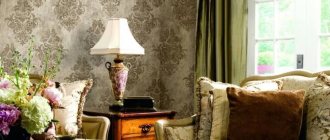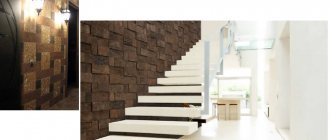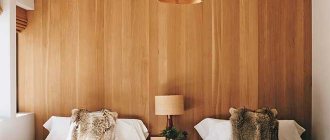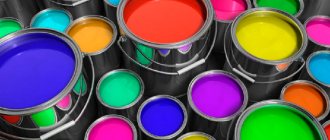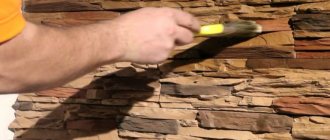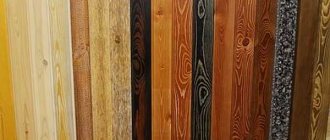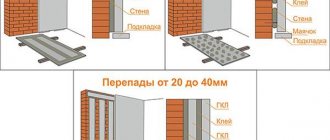The basis of the interior of any house, apartment or office space is floors. Today there are a large number of floor coverings that you can choose specifically to suit your room design. Some people choose the most well-known and relatively inexpensive materials, such as linoleum, laminate, carpet or tile. Others prefer new products in the world of flooring or more expensive options - marmoleum, self-leveling floors or parquet.
When choosing a floor covering, you need to consider the room in which it will be laid. After all, different materials carry different characteristics and properties. That is, the floor coverings in the bedroom and hallway should be different, since the traffic in these rooms is different.
Popular flooring for home
The floor covering is selected depending on the purpose of the room, the calculated load, and additional characteristics (moisture resistance, sound insulation, decorative effect). It is better to lay different coverings in a children's room or corridor, especially since construction stores have a lot of decent and high-quality materials in their assortment.
What coatings are in demand:
- Wooden board, pre-treated from moisture and pests.
- Linoleum, produced in rolls of various widths and thicknesses.
- Laminate is one of the most popular options for modern flooring materials.
- Parquet boards are the most expensive type of flooring.
- Carpet is often used in the bedroom, children's room or living room.
- Ceramic tiles are better suited for the kitchen, bathroom, toilet or hallway.
- Self-leveling floors will last a long time without losing their attractive appearance.
- Cork is an environmentally friendly and safe material.
- PVC or vinyl, which is not inferior in characteristics to other options.
It will be easier to understand the choice of flooring for your home if you immediately determine the possible requirements according to operating conditions. In residential premises, it is necessary to use only natural and safe materials that are practical in surface care and create an atmosphere of comfort.
The “right” floor will decorate any interior Source yandex.net
Parquet
Parquet flooring has been known and popular for centuries. Mentions of parquet are found in the works of Pushkin, Akhmatova, and Tsvetaeva. Of course, modern parquet floors differ significantly from the floor coverings of the classic times. Unlike parquet floors of past centuries, when each board was laid separately, today manufacturers offer parquet in the form of panels. You don't have to lay parquet flooring elements in patterns. This stage was completed at the production stage. However, if a person wants to create a unique interior in an apartment, then, of course, he will have to use custom parquet floors.
Valuable types of wood are used to produce parquet panels with a pattern already made on them. The types of wood used for production are birch, oak, ash and other high-strength options. The development of computer technology allows you to independently create a design design from parquet boards. Moreover, there are specialized programs that allow you to calculate the optimal amount of material for a given area.
Parquet floor
Parquet flooring is not cheap, but its attractive, solid appearance matches the money spent on it. However, do not forget that such flooring will require additional care, this is especially true for block parquet. In addition, laying parquet assumes that rough finishing has already been carried out.
How to choose a floor covering: features, pros and cons of different options
In the manufacture of flooring materials, natural wood, wood processing waste, real or artificial stone, polymers, and cork are used. They all differ in characteristics, complexity of maintenance, provide additional sound and heat insulation of the surface, and create comfort and peace in the interior.
Wooden floors
A simple, inexpensive type of finishing that has undoubted advantages. First of all, this is practicality: with proper care, a high-quality board will last for many years. Other undoubted advantages are low cost, ease of installation even when doing the work yourself.
The thickness of the board is selected based on the future load, and laying can be carried out along the width or length of the room, as well as diagonally. Despite all its practicality, wood also has many disadvantages: the need for an additional moisture-proof coating (paint or varnish), the risk of drying out and squeaks, increased “attention” from pests. Finishing floors with wood is also a certain lottery: if the storage conditions of the material are violated, the finished coating may become deformed by absorbing moisture from the air.
Wooden flooring is a universal finishing option Source sw2018.ru
Cork covering
Finishing the floor with cork is a modern and environmentally friendly solution. This material is obtained from recycled cork tree bark. The surface has a unique pattern, softly springs underfoot, and provides additional heat and sound insulation. The price of the material is comparable to laminate or carpet, it is easy to install and repair if necessary.
The disadvantage is considered to be low moisture resistance and the risk of accidental damage from sharp objects. This drawback can be partially mitigated with special protective coatings, but after such treatment the environmental friendliness of the material will be in question.
Cork floors: beauty and practicality Source epochalnisvet.cz
Parquet board
Parquet floor coverings belong to the premium class segment. Natural wood veneer is used in production, but the finished product does not have the disadvantages of a wooden board. Special treatment makes it possible to achieve moisture resistance, resistance to mechanical shock, abrasion and other negative operating factors.
Few types of flooring can boast of the advantages of parquet, but it also has disadvantages. First of all, this is the high cost, as well as the need for careful installation, on which the durability of the floor will largely depend.
Linoleum
When listing modern floor coverings, it is impossible to ignore traditional linoleum floors. This material has been tested for decades of use, and is constantly being improved and improved. A textured surface, an additional soundproofing felt backing, an assortment of colors and a skillful imitation of natural wood are the main advantages of this option. You can also add trouble-free installation, affordable cost, moisture resistance and abrasion resistance to the surface.
You can choose linoleum for your home in any style from a large number of offers Source dizainexpert.ru
The disadvantages are the destruction of the structure under the influence of low temperatures, the need to prepare the surface before laying the roll.
Marmoleum
Different types of marmoleum
The naturalness and environmental friendliness of finishing materials play an important role in their selection. When choosing a floor covering, you should pay attention to marmoleum, a material that appeared in the last century and is based on natural materials - chalk, jute, balsa wood, wood flour.
Thanks to its natural composition, the scope of application of marmoleum extends to educational (schools, universities), medical and health institutions, and kindergartens.
The main advantages of marmoleum:
- long service life - up to 20 years;
- composition of marmoleum - natural ingredients;
- resistance to chemical components (acids, salts, all kinds of reagents);
- fire resistance;
- antistatic;
- bactericidal properties (especially important for families with children);
- resistance to physical impact. A square meter of marmoleum can withstand up to 160 kg of load without consequences;
- UV resistance;
- the material is also not afraid of high humidity: when interacting with moisture, its properties do not change;
- economical due to self-sufficiency: this flooring does not require additional hydro, noise and thermal insulation;
- the price per square meter of the product is on the same level as laminate;
- simplicity of laying the material, allowing you to carry out the process yourself, without the help of professionals.
The disadvantages of marmoleum include its fragility; therefore, when choosing marmoleum, you should carefully check each element for cracks or other deformations. Transport and transfer of material should be carried out with the utmost care, avoiding deformation of the edges of the product. The material cuts quite poorly.
90% of marmoleum produced is in rolls. The standard width reaches 2 m, the thickness limits are 2-2.5 mm. For objects with increased load, the thickness of the product is 3.2 and 4 mm.
Video description
The secrets of laying and successfully joining the edges of linoleum are shown in this video.
See also: Catalog of companies that specialize in the repair, reconstruction and rebuilding of houses
Modern laminate
Listing the popular types of flooring for the home, laminate is considered the most popular option. In terms of its characteristics, it is not inferior to natural wood and parquet, is affordable, has an excellent appearance, and a textured surface.
Disadvantage - relatively complex installation, the need to level the base, use a special substrate (increases the cost of repairs). For a kitchen or bathroom, it is recommended to use laminate with increased moisture-resistant characteristics. Another disadvantage is the risk of mechanical damage to the surface due to accidental falling of objects or impact.
Laminate will decorate any home, looks great and will last for many years Source styldoma.ru
Envelope tiling
Envelope cladding is a specific type of floor cladding that is used in rooms where the floor is intentionally sloping to allow water to drain. In the vast majority of cases we are talking about showers. It should be especially emphasized that “envelope” cladding is not performed if the misalignment of the floor is not included in the architectural design, but appears as a result of the negligence of the builders. In this case, the surface is leveled and the tiles are laid in the usual way.
When cladding “in an envelope”, the work is carried out according to a plan slightly modified compared to standard cladding.
- Floor markings. First, they mark where the “ladder” is located - the hole for water drainage and the cutting lines located perpendicular to it. They form four triangles along which the tiles will be laid.
- Installation of frieze. The frieze row is laid out around the perimeter. The tiles are laid without a slope.
- Installation of beacons. The lighthouse row is laid out in a triangle, which is located opposite the entrance and perpendicular to the frieze. The direction of the beacons is controlled using a square.
- Covering the main surface. The background tiles are laid in the usual manner. The floor slope specified in the design is maintained by changing the thickness of the adhesive. Where the floor level is lower, the glue is applied in a layer about 7 - 15 mm thick. Gradually the layer thickness is increased to 40 mm.
The cut tiles are laid along the cutting line.
The triangles are faced in the following order: first, the one located opposite the entrance. Then its closest neighbors are lined one by one. The last to be lined is the triangle adjacent to the entrance.
The facing of each triangle begins with the creation of a lighthouse row in the direction of the ladder.
Video description
Features of choosing a laminate and calculating the cost of flooring are given in the video instructions:
Floor tiles
Modern types of floor coverings include the use of ceramic tiles, although previously this option was considered exclusively for wall decoration. Floor tiles come in a wide variety of colors, sizes, and are decorated with various prints. The main difference from wall materials is the non-slip surface, which ensures safety of use.
Pros of coverage:
- Durable, durable surface.
- Absolute moisture resistance.
- Long service life.
- Affordable price.
Disadvantages include labor-intensive installation that requires special skills. The surface can be damaged by an accidental drop of a heavy object, although replacing a broken tile will be cheaper and easier than repairing other surfaces.
The tiles on the floor look very unusual Source simplestroy.ru
Video description
Video instructions for creating self-leveling floors with a pattern are given below.
Carpet for home
Carpet flooring for a room cannot be considered the most practical, but it is the most comfortable and original option for flooring. Typically, carpet is chosen for a nursery or bedroom; it differs in type, fiber size, colors, and quality. Fastening is carried out using skirting boards or special brackets, which takes a minimum of time.
Main advantages:
- Good sound and heat insulation.
- Beautiful colors and prints.
- Creating a cozy atmosphere in the room.
The main difficulty that you may encounter later is the difficulty of constant care. In addition to a vacuum cleaner, you will need regular cleaning to remove stains or dirt, which may require the help of a cleaning company. Despite the special impregnations used in the production of carpets, the material is not durable, and can also fade in the sun.
Carpet will be an effective addition to the interior Source yellowhome.ru
How to choose flooring for different rooms in the house
Covering floors in a house with the same coating has long been out of trend, especially since different rooms have different requirements for the choice of materials. To find out which flooring to choose for different rooms, it is worth analyzing the main “enemies” that can destroy the floor surface. This is mainly moisture, temperature changes, and increased physical activity. Based on these data, the important selection points can be briefly summarized.
Basic criteria when purchasing flooring
- Moisture resistance, resistance to abrasion and physical stress are important for the kitchen All possible contamination should be easily washed off without harming the surface. All these requirements are fully met by linoleum, self-leveling floors, and ceramic tiles.
- Floor coverings in bathrooms and toilets are permissible only with exclusively moisture-resistant coatings that are easy to clean. The surface should not be subject to bacterial contamination and can be easily cleaned with detergents. Suitable types of coatings are also quite diverse: these are self-leveling floors, tiles, linoleum. Some types of laminate are also highly resistant to moisture and can be used for bathroom cladding.
The bathroom floor is made of moisture-resistant materials Source pol-exp.com
DIY floor finishing
How to install laminate flooring in a house yourself
For those who decide to install the floor themselves, there is an unshakable rule: no matter what types of floors you plan for the apartment, a high-quality foundation must be provided for them. This rule must be followed both when renovating an old house or apartment, and when finishing floors in a new building.
Before purchasing floor finishing materials, you should weigh all the positive and negative qualities of different materials. In such a technological process as floor finishing, price matters, but thanks to the huge variety of products offered, each buyer can find the most suitable option according to their needs and capabilities.
Materials, Practical advice, Works, Theory
Briefly about the main thing
When choosing flooring for an apartment, you should evaluate not only financial capabilities, but also the features of each room. Ideally, it is this factor that should be taken into account when purchasing.
The main characteristics for the selected material for the bathroom, toilet and kitchen are: moisture resistance, abrasion resistance, ease of cleaning. For the living room and bedroom, the key factor will be compliance with the overall interior style, attractive design, sound and heat insulation. For a balcony or loggia, you should choose materials that can withstand possible temperature changes, and in the corridor, the main requirement will be physical strength and abrasion resistance of the surface.
Ratings 0
Development of linoleum laying
The whole process of installing linoleum on the floor can be divided into a couple of steps:
Surface preparation:
- Make the best temperature conditions - at least 18°C, humidity up to 60° two days before and two days after finishing the flooring;
- Dismantle the baseboards, remove all debris and dry the surface;
- Seal cracks in the cement base;
- The floor must be insulated with fiberboard pages.
Preparing the coating. Place the rolls vertically and leave them in this position for two days. Linoleum must be located in the room in which it will lie. One day before installation, roll out the roll, cut it taking into account the bends near the doorway and walls.
Laying without fixation:
- Lay out linoleum and tuck seam allowances;
- If 1 canvas is missing, then it is necessary to join the sketch of different segments;
- Glue the connections with double-sided tape or mastic;
- Place a ruler touching the wall and draw it with a sharp knife, cutting off excess fabric;
- Install baseboards.

